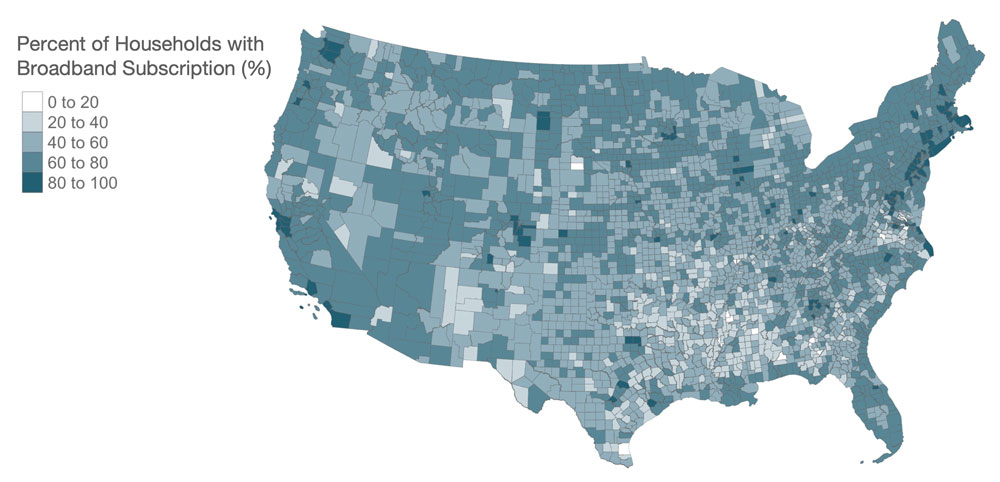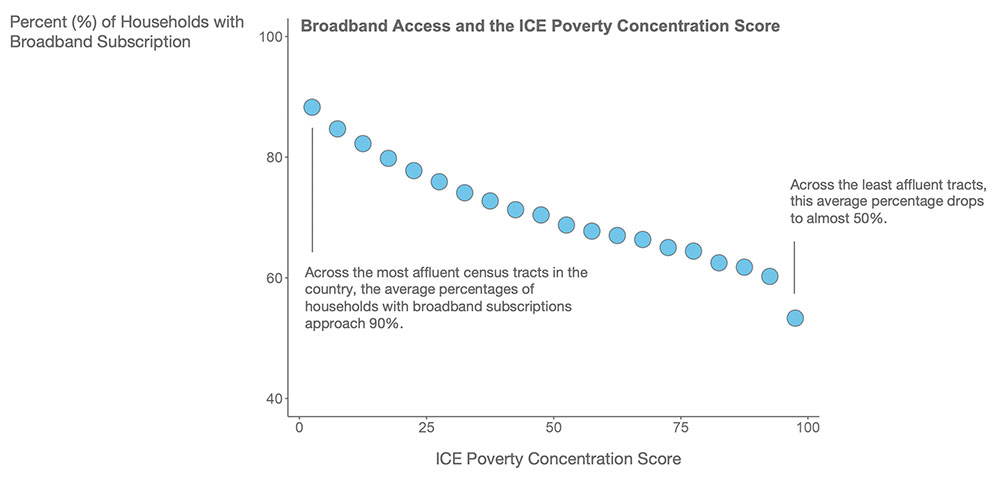
Municipal bonds and internet access: improving the United States' most inequitable infrastructure1
Published
July 2023
Takeaways
- Low-income communities across the United States have significantly less access to high-speed internet on average than affluent communities.
- Because access to high-speed internet is associated with economic, health, and social benefits, municipal bonds issued to fund construction of broadband networks could be considered potentially beneficial to both the long-term fiscal stability of local municipalities and the health and well-being of people living in them.

Click image to enlarge
The insight
Access to broadband internet is associated with a myriad of economic benefits including local growth, lower unemployment, increased household income levels, the number of business, and general entrepreneurial activity. 3,4,5,6,7 High-speed internet may also have social and health benefits, including easier access to social supports and telehealth resources. The transition of schools across the country to remote learning during the COVID-19 pandemic highlighted the critical importance of this digital resource to education.
Disparities in broadband access are often characterized in terms of urban-rural divide. According to the Federal Communications Commission, over 22% of Americans living in rural areas and over 27% in Tribal lands lack broadband coverage; in urban areas, this number falls to under 2%9. The broadband divide can also be understood in terms of income level: analysis of the relationship between the ICE Poverty Concentration Score—a score designed to quantify relative poverty levels across the country—and the percentage of households with a broadband subscription by census tract demonstrates why the Brookings Institute calls broadband internet the country’s “most inequitable infrastructure.”
Across the municipal bond market, standards used for “Green” or “Sustainable” or “Social” labels often come from the International Capital Markets Association’s (ICMA) guiding principles. However, many municipalities do not use these labels on their issuances, even when such designations could be appropriate. Because of the positive economic outcomes associated with broadband access, many municipal bonds issued to improve or create broadband networks in low-income areas with low broadband access are likely to be aligned with the United Nations Sustainability Development Goals (UNSDGs), including Goal 1 (No Poverty), Goal 2 (Good Health and Well-being), Goal 9 (Industry, Innovation, and Infrastructure), and Goal 10 (Reduced Inequality). In these cases, issuers could benefit from labeling bonds for broadband infrastructure as “Social”; doing so could generate interest from impact investors looking for UNSDG-aligned opportunities.
The tools and analysis behind these visualizations
The U.S. Census publishes the percent of households with a broadband subscription by census tract across the United States. ICE uses auxiliary spatial data like the locations of residential and commercial buildings to downscale these census-provided data onto a national 100-m x100 m nested grid which can then be re-aggregated back up to any geographical boundary of interest. This kind of geographically targeted information can reveal important trends and insights, especially when combined with other tools like the ICE Poverty Concentration Score.

Click image to enlarge
Sources: ICE Data as of 1/06/232
1 Tomer et al. (2020)
2 ICE metrics are generated using 2020 U.S. Census Data.
3 Tomer, A., Fishbane, L., Siefer, A., & Callahan, B. (2020, February 27). Digital prosperity: How broadband can deliver health and equity to all communities, Metropolitan Policy Program at Brookings, https://www.brookings.edu/wp-content/uploads/2020/02/20200227_BrookingsMetro_Digital-Prosperity-Report-final.pdf
4 Isley, C., Low, S. (Aug, 2022). Broadband adoption and availability: Impacts on rural employment during COVID-19. Telecommunications Policy, 46(7), 102310, doi: 10.1016/j.telpol.2022.102310.
5 Conroy, T., Low S. (2022). Entrepreneurship, broadband, and gender: Evidence from establishment births in rural America. International Regional Science Review, 45(1), doi: 10.1177/01600176211018749.
6 Mack E., Anselin, L., Grubesic, T.H. (2011). The importance of broadband provision to knowledge intensive firm location. Regional Science Policy & Practice, 3(1), 17–35.
7 Whitacre, B., Gallardo R., Strover S. (2014). Broadband's contribution to economic growth in rural areas: Moving towards a causal relationship, Telecommunications Policy, 38(11), 1011–1023.
8 Patrick, S., Jason, A. Grissom, S. Woods, C. & Newsome, U. (2021). Broadband access, district policy, and student opportunities for remote learning during COVID-19 school closures. AERA Open 7, https://doi.org/10.1177/2332858421106429.
9 Federal Communications Commission (2020). 2020 Broadband Deployment Report, https://docs.fcc.gov/public/attachments/FCC-20-50A1.pdf